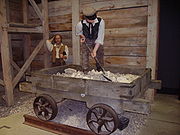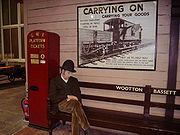
Swindon Steam Railway Museum
Encyclopedia

Swindon
Swindon is a large town within the borough of Swindon and ceremonial county of Wiltshire, in South West England. It is midway between Bristol, west and Reading, east. London is east...
, England
England
England is a country that is part of the United Kingdom. It shares land borders with Scotland to the north and Wales to the west; the Irish Sea is to the north west, the Celtic Sea to the south west, with the North Sea to the east and the English Channel to the south separating it from continental...
– Wiltshire
Wiltshire
Wiltshire is a ceremonial county in South West England. It is landlocked and borders the counties of Dorset, Somerset, Hampshire, Gloucestershire, Oxfordshire and Berkshire. It contains the unitary authority of Swindon and covers...
's 'railway town
Railway town
A railway town is a settlement that originated or was greatly developed because of a railway station or junction at its site.In Victorian Britain, the spread of railways greatly affected the fate of many small towns...
'. The museum opened in 2000 and replaced the former GWR
Great Western Railway
The Great Western Railway was a British railway company that linked London with the south-west and west of England and most of Wales. It was founded in 1833, received its enabling Act of Parliament in 1835 and ran its first trains in 1838...
Museum, which was located on Faringdon Road in Swindon.
Apart from the museum itself, the site has become home to the McArthur Glen Designer Outlet
Swindon Designer Outlet
thumb|right|Swindon Designer Outlet, a shopping complex built within the disused Swindon railway engine works.thumb|right|A Swindon-built locomotive on display in the eating area of the Outlet...
and, since 2005, the Head Office of the National Trust
National Trust for Places of Historic Interest or Natural Beauty
The National Trust for Places of Historic Interest or Natural Beauty, usually known as the National Trust, is a conservation organisation in England, Wales and Northern Ireland...
.
The site


Swindon Works
Swindon railway works were built by the Great Western Railway in 1841 in Swindon in the English county of Wiltshire.-History:In 1835 Parliament approved the construction of a railway between London and Bristol. Its Chief Engineer was Isambard Kingdom Brunel.From 1836, Brunel had been buying...
of the Great Western Railway
Great Western Railway
The Great Western Railway was a British railway company that linked London with the south-west and west of England and most of Wales. It was founded in 1833, received its enabling Act of Parliament in 1835 and ran its first trains in 1838...
, which was one of the largest in the world and operated from 1843 to 1986. In its heyday, it covered more than 300 acres (121.4 ha), and could turn out three locomotive
Locomotive
A locomotive is a railway vehicle that provides the motive power for a train. The word originates from the Latin loco – "from a place", ablative of locus, "place" + Medieval Latin motivus, "causing motion", and is a shortened form of the term locomotive engine, first used in the early 19th...
s per week.
The museum
Apart from many exhibits of interest to railway engine and rolling stockRolling stock
Rolling stock comprises all the vehicles that move on a railway. It usually includes both powered and unpowered vehicles, for example locomotives, railroad cars, coaches and wagons...
enthusiasts, it tells the social story of the railway community in Swindon, with recorded personal experiences and film archives. Life-like exhibits show people at work and human interactions. There are exhibits explaining the construction of locomotive
Locomotive
A locomotive is a railway vehicle that provides the motive power for a train. The word originates from the Latin loco – "from a place", ablative of locus, "place" + Medieval Latin motivus, "causing motion", and is a shortened form of the term locomotive engine, first used in the early 19th...
s, of railway equipment and of the railways themselves. It also tells the history of the Great Western Railway
Great Western Railway
The Great Western Railway was a British railway company that linked London with the south-west and west of England and most of Wales. It was founded in 1833, received its enabling Act of Parliament in 1835 and ran its first trains in 1838...
and the life of Isambard Kingdom Brunel
Isambard Kingdom Brunel
Isambard Kingdom Brunel, FRS , was a British civil engineer who built bridges and dockyards including the construction of the first major British railway, the Great Western Railway; a series of steamships, including the first propeller-driven transatlantic steamship; and numerous important bridges...
, the famous Victorian
Victorian era
The Victorian era of British history was the period of Queen Victoria's reign from 20 June 1837 until her death on 22 January 1901. It was a long period of peace, prosperity, refined sensibilities and national self-confidence...
engineer, who masterminded the Great Western Railway. There are many hands-on exhibits and interactive displays. Enthusiastic ex-railway workers are on hand, to give a personal insight into many of the exhibits.
There is a series of reconstructions of areas of work, such as office, stores, workshop, signal box and foundry.
The museum holds a massive archive of books, periodicals, photographs, drawings and plans, relating to the Great Western Railway.
Location
The museum is near Swindon's town centre, adjacent to the McArthur Glen Designer Outlet Village. It is located at Ordnance SurveyOrdnance Survey
Ordnance Survey , an executive agency and non-ministerial government department of the Government of the United Kingdom, is the national mapping agency for Great Britain, producing maps of Great Britain , and one of the world's largest producers of maps.The name reflects its creation together with...
mapping six-figure .
Collection
The museum is home to several GWR pre-nationalization-era locomotives, two of which are the first members of their respective classes. The majority of these are part of the UK National Collection.- GWR Star ClassGWR Star ClassThe Great Western Railway Star Class of 2-2-2 broad gauge steam locomotives were used for passenger train work. Designed by Robert Stephenson, the class was introduced into service between November 1838 and November 1841, and withdrawn between April 1864 and September 1871.A total of twelve Star...
North Star – a replica of an early broad gaugeBroad gaugeBroad-gauge railways use a track gauge greater than the standard gauge of .- List :For list see: List of broad gauges, by gauge and country- History :...
locomotive. Part of the National Collection - GWR 2301 ClassGWR 2301 ClassThe Great Western Railway 2301 Class or Dean Goods Class is a class of British 0-6-0 steam locomotives.Swindon railway works built 260 of these goods locomotives between 1883 and 1899 to a design of William Dean...
2516 - part of the National Collection - GWR 4073 Class 4073 Caerphilly CastleGWR 4073 Class 4073 Caerphilly CastleCaerphilly Castle is a member of the GWR 4073 Class built in 1923. Its first shed allocation was Old Oak Common. Its August 1950 shed allocation was Bath Road, Bristol. Its last shed allocation was Cardiff Canton in March 1959...
– on static display, part of the National Collection - GWR 9400 ClassGWR 9400 ClassThe Great Western Railway 9400 Class is a class of 0-6-0 pannier tank steam locomotive, used for shunting and banking duties.The first ten 9400s were the last steam engines built by the GWR. After nationalisation in 1948, another 200 were built by private contractors for British Railways...
9400 – part of the National Collection - GWR 4200 ClassGWR 4200 ClassThe Great Western Railway 4200 Class is a class of 2-8-0T steam locomotives. They were designed for short-haul coal trips from coal mines to ports in South Wales. The principal role of the class was working the 1000+ ton coal trains up through the Welsh valleys. A job which needed much tractive...
4248 – on static display, largely dismantled to look like a locomotive in the works - GWR 4000 Class 4003 Lode StarGWR 4000 Class 4003 Lode StarLode Star is the only remaining GWR 4000 Class locomotive. It is preserved at the National Railway Museum, York, UK.Lode Star was designed by George Jackson Churchward and was built in 1907, one of the first locomotives in its class to be built....
- Arrived in November 2010 from the National Railway MuseumNational Railway MuseumThe National Railway Museum is a museum in York forming part of the British National Museum of Science and Industry and telling the story of rail transport in Britain and its impact on society. It has won many awards, including the European Museum of the Year Award in 2001...
as a replacement for Evening StarBR standard class 9F 92220 Evening StarBritish Railways Standard Class 9F number 92220 Evening Star, is a preserved British steam locomotive completed in 1960. It was the last steam locomotive to be built by British Railways. It holds the distinction of being the only British main line steam locomotive ear-marked for preservation from... - GWR 7800 Class 7821 Ditcheat ManorGWR 7800 Class 7821 Ditcheat ManorGreat Western Railway 7800 Class No. 7821 Ditcheat Manor is a preserved British steam locomotive.The second of the last batch of 10 engines of her thirty-strong class, she was actually built by British Railways in 1950. Like most of her class of lightweight 4-6-0s, she was allocated to lines in...
- on static display, on loan from the West Somerset RailwayWest Somerset RailwayThe West Somerset Railway is a railway line that originally linked and in Somerset, England.It opened in 1862 and was extended from Watchet to by the Minehead Railway in 1874. Although just a single track, improvements were needed in the first half of the twentieth century to accommodate the...
The museum also displays a small collection of Great Western rolling stock and equipment, including:
- GWR RailcarGWR railcarsIn 1933, the Great Western Railway introduced the first of what was to become a very successful series of railcars, which survived in regular use into the 1960s, when they were replaced with the new British Rail "first generation" type diesel multiple units....
W4W – Static, Part of National Collection

